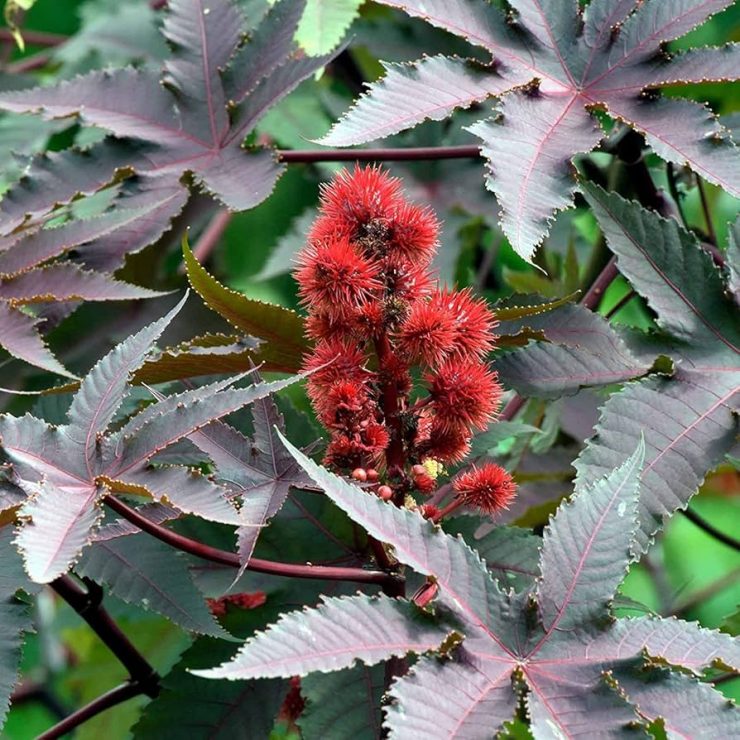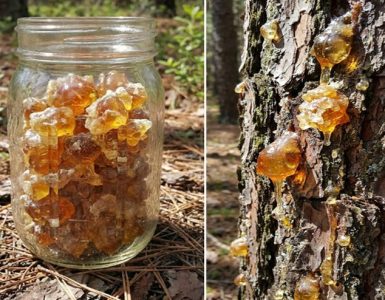The castor bean plant (Ricinus communis) is a fast-growing, tropical plant known for its striking foliage, oil-rich seeds, and toxic properties. It is cultivated worldwide for industrial, medicinal, and ornamental purposes. Here’s everything you need to know about this fascinating plant.
1.General Characteristics
Scientific Name: Ricinus communis
Common Names: Castor bean plant, castor oil plant, Palma Christi
Family: Euphorbiaceae (spurge family)
Origin: Native to Africa and India but now found worldwide in tropical and subtropical regions
Growth Habit: A perennial shrub or small tree in warm climates, grown as an annual in temperate regions
Height: Can reach 6–10 feet (1.8–3 meters) in a single growing season and up to 40 feet (12 meters) in warm climates
2.Appearance and Identification
Leaves
Large, palmate (hand-shaped) leaves with 5–12 deeply lobed segments
Glossy, dark green, red, or purple in color, depending on the variety
Can grow up to 3 feet wide
Flowers
Monoecious (produces separate male and female flowers on the same plant)
Female flowers appear at the top, while male flowers cluster below
Small, yellowish-green, and inconspicuous
Seeds (Castor Beans)
Encased in spiny, capsule-like fruits
Shiny, speckled, oval-shaped with brown, black, or gray mottling
Highly toxic due to ricin, even in small quantities
3.Growing Conditions and Cultivation
The castor bean plant is easy to grow and thrives in various climates with the right conditions.
Sunlight
Requires full sun (at least 6–8 hours per day)
Grows best in warm, tropical, and subtropical climates
Soil
Prefers well-drained, fertile, and loamy soil
pH range: 6.0–7.5 (neutral to slightly acidic)
Watering
Moderate watering; prefers consistent moisture but does not tolerate waterlogging
Drought-tolerant once established
Temperature
Thrives in temperatures between 70–90°F (21–32°C)
Frost-sensitive and will die back in cold climates
Propagation
Seeds germinate quickly (within 7–14 days) in warm soil
Soak seeds overnight before planting to speed up germination
Space plants at 3–5 feet apart for good air circulation
4.Uses of Castor Bean Plant
Industrial Uses
Castor oil extracted from the seeds is used in lubricants, biodiesel, cosmetics, plastics, and paints
The oil is prized for its high viscosity and resistance to oxidation
Medicinal Uses
Castor oil has been used as a natural laxative, skin moisturizer, and anti-inflammatory remedy
Used in traditional medicine for treating constipation, arthritis, and skin conditions
Ornamental Uses
Popular in landscaping due to its exotic foliage and rapid growth
Often used as a privacy screen or windbreak
Pest Control
The plant has natural insect-repellent properties
Used to deter moles, voles, and rodents
5.Toxicity and Dangers
While the plant has many benefits, it is highly toxic due to the presence of ricin, one of the most potent natural poisons.
Poisonous Parts
Seeds (most toxic) – Just one or two seeds can be lethal to humans
Leaves and stems contain lesser amounts of toxins
Symptoms of Ricin Poisoning
Ingestion: Nausea, vomiting, abdominal pain, diarrhea, dehydration, organ failure
Skin Contact: Possible irritation from crushed seeds or plant sap
Inhalation: If ricin is inhaled (rare in natural settings), it can cause severe respiratory distress
Handling Precautions
Wear gloves when handling seeds or pruning the plant
Keep away from children and pets
Never consume raw seeds
First Aid
If ingested, seek medical attention immediately
There is no antidote for ricin poisoning, but early treatment can be life-saving
6.Pest and Disease Control
Common Pests
Aphids – Can be controlled with neem oil or insecticidal soap
Spider mites – Increase humidity and use horticultural oil
Caterpillars – Handpick or use organic pesticides if necessary
Common Diseases
Fungal infections (root rot, leaf spot) due to excessive moisture
Prevent by ensuring good drainage and proper air circulation
7.Harvesting and Oil Extraction
Harvesting Seeds
Harvest pods when they turn brown and dry out
Wear gloves and handle with care to avoid exposure to toxins
Oil Extraction
Castor oil is extracted through cold pressing or solvent extraction
The toxic ricin is removed during the oil refinement process
8.Castor Bean Plant as an Invasive Species
Highly invasive in warm climates due to rapid growth and seed dispersal
Found in disturbed lands, roadsides, and riverbanks
Control methods include cutting, herbicide application, or restricting seed production
9.Interesting Facts
One of the fastest-growing plants, capable of reaching full size within a season
Castor oil was used in ancient Egypt for lamp fuel and medicinal purposes
The US and Russia once studied ricin as a bioweapon due to its toxicity
The castor bean plant is a beautiful yet highly toxic plant with various industrial, medicinal, and ornamental uses. While it offers valuable castor oil, its seeds contain ricin, making it dangerous if consumed. With proper handling and care, it can be a stunning addition to a garden but should be managed carefully to prevent toxicity risks and invasiveness.






Add comment